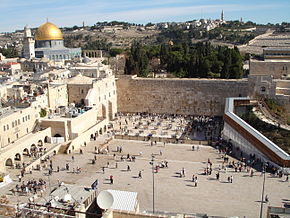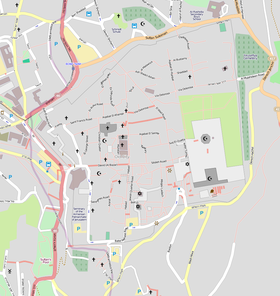Western wall
 |
|
| Alternate name | Wailing Wall Kotel Al-Buraq Wall |
|---|---|
| Location | Jerusalem |
| Coordinates | 31°46′36″N 35°14′04″E / 31.7767°N 35.2345°ECoordinates: 31°46′36″N 35°14′04″E / 31.7767°N 35.2345°E |
| Length | 488 metres (1,601 ft) |
| Height | exposed: 19 metres (62 ft) |
| History | |
| Builder | Herod the Great |
| Material | Limestone |
| Founded | 19 BCE |
| Site notes | |
| Condition | preserved |
The Western Wall, Wailing Wall or Kotel (Hebrew: ![]() הַכֹּתֶל הַמַּעֲרָבִי , translit.: HaKotel HaMa'aravi; Ashkenazic pronunciation: Kosel; Arabic: حائط البراق, translit.: Ḥā'iṭ al-Burāq, translat.: the Buraq Wall, or Arabic: المبكى al-Mabkā: the Place of Weeping) is an ancient limestone wall in the Old City of Jerusalem. It is a relatively small segment of a far longer ancient retaining wall, known also in its entirety as the "Western Wall". The wall was originally erected as part of the expansion of the Second Jewish Temple by Herod the Great, which resulted in the encasement of the natural, steep hill known to Jews and Christians as the Temple Mount, in a large rectangular structure topped by a huge flat platform, thus creating more space for the Temple itself and its auxiliary buildings.
הַכֹּתֶל הַמַּעֲרָבִי , translit.: HaKotel HaMa'aravi; Ashkenazic pronunciation: Kosel; Arabic: حائط البراق, translit.: Ḥā'iṭ al-Burāq, translat.: the Buraq Wall, or Arabic: المبكى al-Mabkā: the Place of Weeping) is an ancient limestone wall in the Old City of Jerusalem. It is a relatively small segment of a far longer ancient retaining wall, known also in its entirety as the "Western Wall". The wall was originally erected as part of the expansion of the Second Jewish Temple by Herod the Great, which resulted in the encasement of the natural, steep hill known to Jews and Christians as the Temple Mount, in a large rectangular structure topped by a huge flat platform, thus creating more space for the Temple itself and its auxiliary buildings.
The Western Wall is considered holy due to its connection to the Temple Mount. Because of the status quo policy, the Wall is the holiest place where Jews are permitted to pray, though it is not the holiest site in the Jewish faith, which lies behind it. The original, natural and irregular-shaped Temple Mount was gradually extended to allow for an ever-larger Temple compound to be built at its top. This process was finalised by Herod, who enclosed the Mount with an almost rectangular set of retaining walls, built to support extensive substructures and earth fills needed to give the natural hill a geometrically regular shape. On top of this box-like structure Herod built a vast paved esplanade which surrounded the Temple. Of the four retaining walls, the western one is considered to be closest to the former Temple, which makes it the most sacred site recognised by Judaism outside the former Temple Mount esplanade. Just over half the wall's total height, including its 17 courses located below street level, dates from the end of the Second Temple period, and is commonly believed to have been built around 19 BCE by Herod the Great, although recent excavations indicate that the work was not finished by the time Herod died in 4 BCE. The very large stone blocks of the lower courses are Herodian, the courses of medium-sized stones above them were added during the Umayyad era, while the small stones of the uppermost courses are of more recent date, especially from the Ottoman period.
...
Wikipedia

